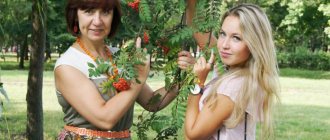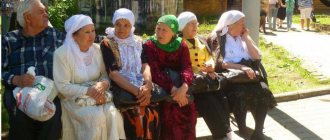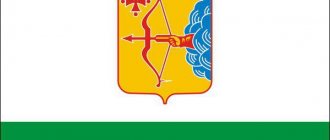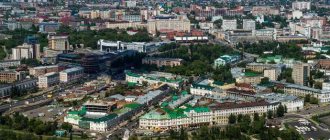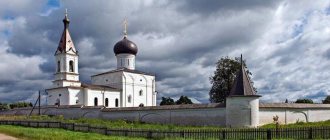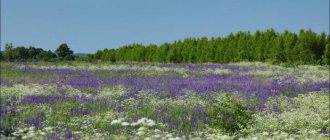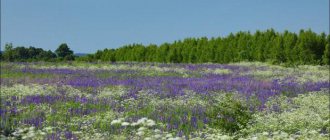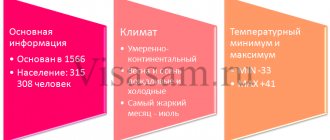The population of the Arkhangelsk region is extremely unevenly distributed. If the capital of the region, the city of Arkhangelsk, has a population of approximately 1,200 people per square kilometer, then, for example, the Nenets Autonomous Okrug is the most sparsely populated subject of the Russian Federation. There the population density is only 0.25 people/km2. As in many regions of the country, in the Arkhangelsk region, an outflow of population began in 1992. However, it has now slowed down a bit. Oil deposits were found in the region, so unemployment has decreased, and the socio-economic situation is quite stable.
What holiday is it today?
December 16, 2021, Thursday
Today are holidays, events: Events that happened on December 16 in the world, in different years Tomorrow: Day of Strategic Missile Forces Day of Employees of the State Courier Service Memorable date in the military history of Russia: Capture of the Ochakov fortress in 1788
Today is the Orthodox holiday of the Prophet Zephaniah. Reverend Savva of Storozhevsky, Zvenigorod. Martyr Angelis... Tomorrow: Great Martyr Barbara and Martyr Juliania of Iliopolis. Venerable John of Damascus...
Today is a national holiday: Day of World Silence and Silence... Tomorrow: Barbarian Day...
Seasons
Seasons, four periods of the year (spring, summer, autumn and winter) characterized by certain average temperatures. The period during which the Sun passes through one of these sectors is called the season. Spring in the Northern Hemisphere and autumn in the Southern Hemisphere begin when the Sun passes through the initial circle of declination and its right ascension is 0° (vernal equinox). Summer in the Northern Hemisphere and winter in the Southern Hemisphere occur when the sun's right ascension is 90° (summer solstice). Autumn in the Northern Hemisphere and spring in the Southern Hemisphere begin when the sun's right ascension is 180° (autumnal equinox). The beginning of winter in the Northern Hemisphere and summer in the Southern Hemisphere is considered to be the winter solstice, when the direct ascension of the Sun is 270°... Next: Seasons. Russian folk calendar. Monthly words...
Stone Age
As already mentioned, the population of the Arkhangelsk region began to organize a very long time ago. But today it’s even difficult to imagine that the first inhabitants in these territories began to appear when the glaciers had just left the shores.
Modern archaeologists have discovered supposed sites of ancient people. Scientists have suggested that the settlements date back to the Paleolithic period. The savages settled in the area of the Pechera River, where the Nenets Autonomous Okrug is now located. Also, rare objects of that era were discovered in the middle reaches of the Northern Dvina. Now this is the area between the villages of Ichkovo and Stupino.
The Middle Stone Age is represented by a site called Yavronga-1. It received this name due to the river near which it was located.
Also, the oldest population of the Arkhangelsk region was located on Solovki. The sites Solovetskaya-21, Solovetskaya-4 and Muksalma-6 are more than six thousand years old.
The New Stone Age was a breakthrough compared to previous eras. The development also affected the then residents of the modern Arkhangelsk region. It was established that in the southern part of the region there were pile settlements of the Modlon type. Among the cultures developing in this territory, one can note the Pechora-Dvina and Kargopol.
The era of the birth of civilization is characterized by the emergence of the Sami tribes. They lived on the southern and western coasts of the White Sea.
Archaeologists discovered an iron smelting forge dating back to approximately the same time. It is the oldest in Europe.
Folk calendar about every day
Every day one season always replaces another and this determines a person’s way of life. In connection with this, a folk calendar was formed in which there were practically no nameless, unmarked days. Every day was special, had its own purpose. All this was determined by climate conditions and astrological phenomena.
A calendar is a system for counting periods of time. The first calendars arose a long time ago, in ancient times, because there was a need to measure time. The word calendar comes from the Latin words caleo - to proclaim and calendarium - debt book. This is due to the fact that in Ancient Rome the beginning of each month was especially proclaimed, and because it was customary to pay debts on the first day of the month. Different peoples counted time differently. Some calendars are based on the changing phases of the moon - lunar calendars; in others - the change of seasons - sunny; in others, the length of the year was coordinated with the change of seasons, and the counting of months was associated with the phases of the Moon. Such calendars are called lunisolar.
In Rus', the calendar was called a monthly calendar. Every day, the month book covered the entire year of peasant life, “describing” day by day, month after month, where each day had its own holidays or weekdays, customs and superstitions, traditions and rituals, natural signs and phenomena. The cyclical nature of the calendar is reminiscent of human life, where spring is youth, summer is heyday, autumn is the time of harvesting fruits (it’s good if there are some, otherwise you can live your life without collecting fruits), winter is the time of wisdom and peace. This cyclicality and rhythm determined the way of life of the farmer. The folk calendar was an agricultural calendar, which was reflected in the names of the months, folk signs, rituals and customs. Even the determination of the timing and duration of the seasons is associated with real climatic conditions. Hence the discrepancy between the names of the months in different areas... Next: Folk calendar...
Post-war period
In the post-war years, the region began to gradually develop. Industrialization and industrial development made production in the Arkhangelsk region more mechanized, and machine labor finally replaced manual labor.
Since the sixties, an energy complex was created in the region, geological exploration work began, and agriculture began to have an industrial basis. The number of residents grew, for example, the population of the Arkhangelsk region in 1964 amounted to more than 1.3 million people. In 1987, the population numbered already 1.5 million.
Fishing calendar for every day
The fishing calendar should not be taken as an absolutely indisputable truth. Fish biting is greatly influenced by a whole range of natural factors, as well as the influence on the nature of man himself. You must not forget that the fish’s bite depends and is determined not only by the calendar dates and biological cycles of their life, reflected in the calendar, but also, no less, by the state of their habitat; the bite also depends on weather conditions: air and water temperatures, cloudiness, wind direction and strength, etc... Next: Fishing calendar...
Urban settlements
- Vychegodsky
Population 12,314 (2020).
- Konosha
Population 10,683 (2020).
- Plesetsk
Population 9,789 (2020).
- October
Population 9,016 people (2020).
- Savinsky
Population 6,508 (2020).
- Bereznik
Population 5,292 (2020).
- Kuloy
Population 5,056 people (2020).
- Severonezhsk
Population 4,688 (2020).
- Urdoma
Population 4,116 people (2020).
- Shipitsyno
Population 3,377 (2020).
- Obozersky
Population 3,049 (2020).
- Privodino
Population 3,009 (2020).
- Belushya Guba (Novaya Zemlya)
Population 2,708 (2020).
- Maloshuika
Population 2,320 (2020).
- Kamenka
Population 1,903 (2020).
Orthodox calendar about every day
Orthodox calendar: Orthodox, Church and Christian holidays.
The church year is an alternation of weekdays and holidays. On weekdays, a person is called to work “by the sweat of his brow to earn his bread.” Holidays are given in order to feel liberation, to rise above the bustle and routine of the world, to feel involved in the highest of worlds, “where there are no illnesses, sorrows and sighs, but endless life.” Since ancient times, holiday cycles have been associated with the seasons. The pagans associated them with the worship of the forces of nature, the cult of which in the Old Testament was replaced by gratitude to the Creator for the universe. And although the connection between holidays and the seasons has not completely lost its power, since God is present in everything, in the plant and animal world, in human works, it nevertheless faded into the background, giving way to a spiritual foundation built on the Sacred Scriptures. The history of Orthodox holidays dates back to the times of the Old Testament. Each of the Orthodox holidays is dedicated to the remembrance of the most important events in the life of Jesus Christ and the Mother of God, as well as the memory of saints... Next: Orthodox calendar...
Protected areas
On the territory of the Arkhangelsk region there are such protected parks as Vodlozersky and Kenozersky. As well as the Pinezhsky, Nenets and Bolshezemsky nature reserves. The region also contains the Franz Josef Land state nature reserve, consisting of 192 islands. The total area of the territory is more than 16 thousand square kilometers. The reserve is inhabited by a large number of polar bears, and Arctic foxes are also found among mammals. The waters of the Arctic Ocean are home to sea hares, walruses, seals and others.
Russian folk calendar for every day
The word “sign” comes from the word “notice”, i.e. observe. As a result of observing what happens around a person every day, he accumulates life experience. This knowledge was passed down from generation to generation, carefully preserved and people trusted it as a sacred book. Many signs have come to us from the depths of centuries without losing their knowledge. Each of us is free to choose: to dismiss all this as an absurd superstition or to take a closer look at the signs and take the centuries-old experience of generations more seriously. Most of us, when taking exams, ask them to scold them, boasting about some kind of good fortune or luck, spit so as not to jinx them or knock on wood, take a detour if a black cat crossed the road, are afraid of the number 13 and much more. And who among us does not have lucky things, numbers? Who has never resorted to the help of fate at least once in their life, who has not believed in secrets? It’s as if everything connected with signs is hidden somewhere deep in our subconscious. Often we remember them mechanically, unconsciously, or just as a joke. But, undoubtedly, the signs contain a lot of accurate knowledge and practical wisdom of our ancestors. They cover all the characteristic, often difficult to perceive, natural phenomena. Signs have preserved a lot of what was in old folk holidays and customs; they help predict the weather, grow crops... Next: Folk signs...
Education
Arkhangelsk is home to one of several Russian federal universities - the Northern Arctic Federal University. NArFU included several Arkhangelsk educational institutions, such as the Technical University and Pomeranian University. There is also the Northern State Medical University, which is one of the best medical institutes in the region. There are many foreigners among the university students.
The region also has award-winning secondary education institutions. For example, the Arkhangelsk City Lyceum named after M.V. Lomonosov. Students annually bring prizes from the All-Russian School Olympiad in subjects such as mathematics, social studies, physics, literature, and chemistry. Many teachers of the lyceum are Honored Teachers of Russia.
Holiday calendar, dates and events of the year
All state and professional holidays in Russia, including significant World and International holidays, and other equally interesting holidays and events about every day.
The holiday has always kept pace with the history of mankind. Social time can be divided into three types: everyday life (weekdays), weekends and holidays. Everyday life is a series of practices repeated day after day and every day (work). Weekends are regular breaks from the rush of everyday life. It is believed that on weekends a person should restore his strength after working days. Day off, non-working day. A holiday is a day of celebration established in honor or in memory of someone or something. A day or series of days celebrated by the church in memory of a religious event or saint... Next: Calendar...
Souvenirs
Traditional souvenirs that tourists should definitely buy are birch bark crafts. As well as various linen products. There are also bone carving traditions in some areas. Jewelry, toys, and various memorable trinkets are made using this technique. In the Kargopol region there is a tradition of producing special clay toys.
Tourists also like to bring special roe gingerbread from the Arkhangelsk region. They are baked only in this region of Russia.
Prayer book, Orthodox prayers for every day
Prayer is the most powerful means for healing all illnesses - both physical and mental. Prayers can be laudatory or grateful, petitionary and repentant. If we have offended God, sinned, we must ask Him for forgiveness, that is, repent. Such prayers are called repentant prayers. If everything is fine with us, if we and our loved ones are healthy and prosperous, if we have a place to live, something to wear, something to eat, we must glorify and thank God for this. Such prayers are called praise or thanksgiving. If some misfortune, illness, trouble or need happens, you need to ask God for help. Such prayers are called petitionary... Next: Orthodox prayers...
Zodiac, astrological, eastern calendar. Zodiac signs
In ancient times, to establish the calendar, priests used knowledge of the positions of all the planets. Before the reform of Peter 1, the New Year was celebrated on the Day of the Autumn Equinox. On this day, according to ancient legend, the most peaceful treaty was concluded between the Great Race (ancient Slavs) and the Great Dragon (ancient Chinese) and it was approximately 7518 years ago... For the ancient Slavs, the calendar month corresponded to the lunar cycle from new moon to new moon, taking into account such Thus, the relationship of the entire annual cycle with astronomical and natural phenomena. There was no coherent calendar system. The main natural phenomena are still considered to this day to be the days of the solar equinox and solstice - the Slavic holidays Maslenitsa, Kupala, Ovsen and Kolyada. But during the time of Peter 1, all ancient Slavic calendars were abolished and a new Western European calendar from the Nativity of Christ (Julian calendar) was introduced, while the beginning of the calendar was moved to January 1. The Julian calendar (old style) did not take leap days into account and accumulated one extra day every 128 years. After the October Revolution in 1918, the Gregorian calendar (new style) was introduced in Russia, according to which an amendment of 13 days was introduced. The calendar of the ancient Slavs was based on two planets: the Sun and the Moon. And now they don’t use anything at all. The calendar has become static. There is no such thing as the calendar, it turns out, resting on some planet. Nobody even knows about it. There are just some standard numbers, there are months and holidays. The calendar is based on the Sun and Moon. Why is this so? Because these two luminaries influence the Earth. The Earth revolves around the Sun, and the Moon revolves around the Earth. And these two luminaries create the atmosphere on the planet. From here the calendar is built... Next: Astrological calendar...
The twentieth century
At the beginning of the twentieth century, the entire Arkhangelsk region - the cities, the population - underwent significant changes. During the civil war, the northern territories of Russia were under the control of the Entente and the White Army. The Northern Region was formed. Arkhangelsk became its administrative center.
In 1919, forced labor camps were established in the region.
Two years later, the Autonomous Region of Komi arose. The new region included Arkhangelsk and North Dvina provinces.
Seven years later, such provinces of the USSR as Arkhangelsk, Vologda, and North Dvina were united. Their totality made up the Northern Territory. But its territory was divided into five districts:
- Arkhangelsk;
- Vologda;
- Nenets, administrative center - the village of Telvisochnoe;
- Nyandomsky;
- Severodvinsk, administrative center - Veliky Ustyug.
In the same year, the Nenets National District was founded. It consisted of three districts - Kaninsko-Timansky, Bolshezemelsky and Pustozersky.
Dream books online, interpretation of dreams
A dream book is nothing more than an interpreter of dreams and dreams, a translator of dreams. Since ancient times, people have been using dream books; dreams have always been given great importance, and people have often noticed the prophetic properties of some dreams. The dream book can become your faithful assistant every day and throughout your life, thanks to the dream interpreter you can always make the right decisions, the dream book will help you resist temptations in time, and will warn you against wrong steps and frivolous actions. Further…

